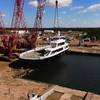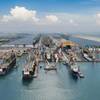Barge Fleet Lighting
Within the U.S. Coast Guard Eighth District alone, marine casualty data indicates that over the past 12 years, 44 recreational vessels have struck (allided) moored barges within barge fleets, resulting in 26 fatalities and 44 injuries. These serious incidents involving barges highlight the critical need for barge operators to properly display navigation lights in accordance with the Inland Navigation Rules. As with all marine casualty investigations, the Coast Guard seeks to identify the specific causal factors involved in each incident, including whether the involved barge fleets are sufficiently lit.
The Coast Guard would like to take this opportunity to remind barge operators of their obligation to meet current barge lighting regulations.
Furthermore, these tragic casualties are a strong warning to recreational boaters of the dangers associated with operating near and around barge fleets.
In July 2014, the Coast Guard published changes to the Inland Navigation Rules. This included amending Rule 30 "Vessels anchored, aground, and moored barges" to incorporate barge lighting requirements previously located in other regulations, including requirements for an unobstructed white light of sufficient intensity to be visible for at least 1 nautical mile.
The Coast Guard urges owners and operators of barge fleets to complete the following actions:
- Review fleet lighting procedures to ensure that barges are sufficiently lit and operated in accordance with the Inland Navigation Rules1, including technical requirements as prescribed in Annex I, as well as any applicable area-specific regulations in 33 CFR Parts 162 and 165. 2
- Ensure that barge fleets remain in compliance with permits issued by U.S. Army Corps of Engineers pursuant to 33 CFR Parts 320 through 332, and/or regional issuing authorities.
The Coast Guard also strongly recommends that owners and operators of all vessels, including recreational vessels, remain extra vigilant when operating boats during nighttime hours, times of reduced visibility, or when strong currents exist and when other navigational challenges posed by barge fleets are present.
This Safety Alert is provided for informational purposes only and does not relieve any domestic or international safety, operational or material requirement. It was developed by the U.S. Coast Guard Eighth Coast Guard District, New Orleans, LA.











